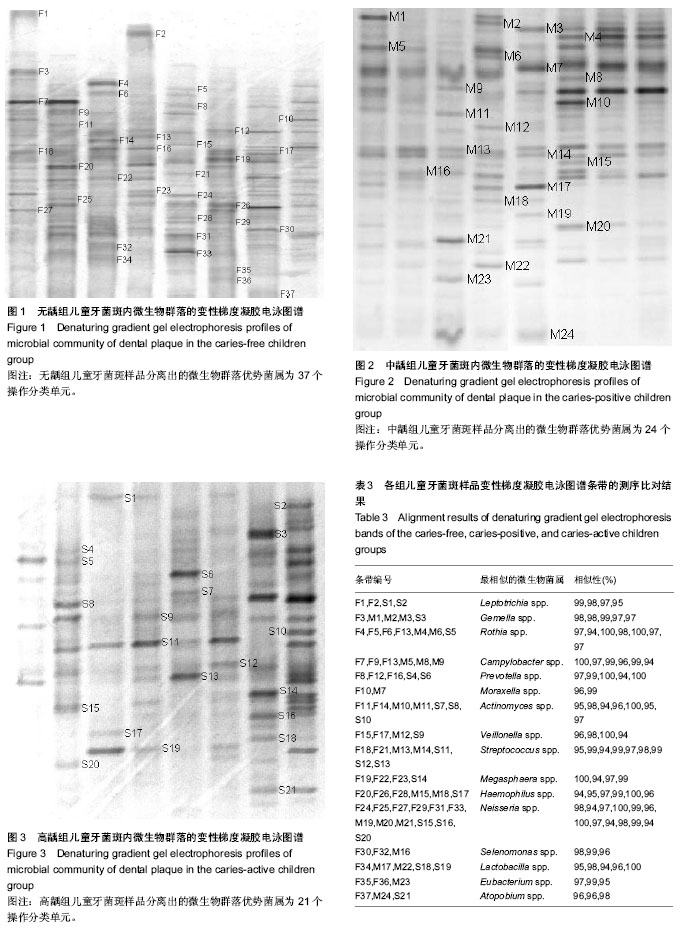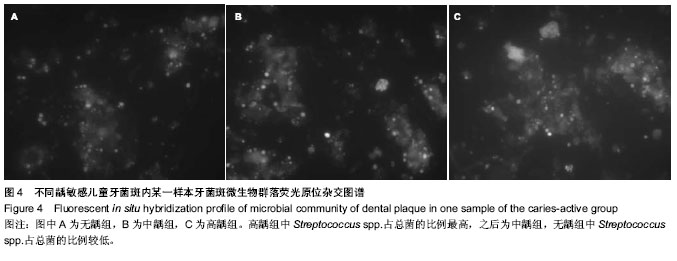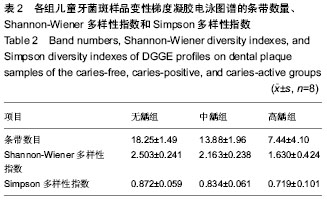| [1] 王瑾,程为庄.玻璃离子水门汀的研究进展[J].北京生物医学工程, 2005,24(2):139-143.
[2] Forsten L.Resin-modified glass-ionomer cements fluoride release and uptake. Acta Odonto Scand.1995;53:222-225.
[3] Aas JA,Paster BJ,Stokes LN,et al.Defining the normal bacterial flora of the oral cavity.J Clin Microbiol. 2005;43(11): 5721-5732.
[4] Marsh PD,Bradshaw DJ.Physiological approaches to the control of oral biofilms. Adv Dent Res.1997;11(1):176-185.
[5] Beighton D.The complex oral microflora of high risk individuals and groups and its role in the caries process. Community Dent Oral Epidemiol. 2005;33(4);248-255.
[6] Pennisi E.A mouthful of microbes. Science. 2005;307(5717): 1899-1901.
[7] Li J,Helmerhorst EJ,Leone CW,et al.Identification of early microbial colonizers in human dental biofilm.J Appl Microbiol. 2004;97(6):1311-1318.
[8] Cowan D,Meyer Q,Staff rd W,et al.Metagenomic gene discovery: Past, present and future.Trends Biotechnol. 2005; 23(6):321-329.
[9] Muyzer G,Smalla K.Application of denaturing gradient gel electrophoresis (DGGE) and temperature gradient gel electrophoresis (TGGE) in microbial ecology. Antonie Van Leeuwenhoek.1998;73(1):127-141.
[10] Palmer C,Bik EM,Eisen MB.Rapid quantitative profiling of complex microbial populations.Nucleic Acids Res. 2006; 34(1):e5.
[11] World Health Organization.Oral health surveys Basic Methods. 4th ed. Geneva: World Health Organization. 1997: 1-21.
[12] Nuebel U,Engelen B,Felske A.Sequence heterogeneities of genes encoding 16S rRNAs in paenibacillus polymyxa detected by temperature gradient gel electrophoresis. J Bacteriol.1996;178:5636-5643.
[13] 刘靖,王韦玮,胡凡,等.荧光原位杂交观察口腔原位菌斑中链球菌和具核梭杆菌的动态变化的研究[J].口腔医学, 2012,32(1): 15-18.
[14] 梁景平,姜云涛,李超伦,等.实时PCR技术在龋易感儿童牙菌斑致龋菌定量检测中的应用[J].上海交通大学学报:医学版, 2007, 27(2):128-132.
[15] Ledder RG,Gilbert P,Pluen A,et al.Individual microflora beget unique oral microcosms.J Clin Microbiol.2006;1123-1131.
[16] Ruby J,Goldner M.Nature of symbiosis in oral disease.J Dent Res.2007;(1):8.
[17] McBain AJ,Bartolo RG,Catrenich CE,et al.Growth and molecular characterization of dental plaque microcosms.J Appl Microbiol.2003;94:655-664.
[18] Fujimoto C,Maeda H,Kokeguchi S,et al.Application of denaturing gradient gel electrophoresis (DGGE) to the analysis of microbial communities of subgingival plaque. J Periodont Res.2003;38:440-445.
[19] Rudney JD,Pan Y,Chen R.Streptococcal diversity in oral biofilms with respect to salivary function.Arch Oral Biol. 2003; 48:475-493.
[20] Rasiah IA,Wong L,Anderson SA,et al.Variation in bacterial DGGE patterns from human saliva: over time,between individuals and in corresponding dental plaque microcosms. Arch Oral Biol.2005;50:779-787.
[21] Li Y,Saxena D,Barnes VM,et al.Polymerase chain reaction- based denaturing gradient gel electrophoresis in the evaluation of oral microbiota.Oral Microbiol Immunol. 2006;21:333-339.
[22] Li Y,Ku CYS,Xu J,et al.Survey of oral microbial diversity using PCR-based denaturing gradient gel electrophoresis.J Dent Res.2005;84(6):559-564.
[23] 姜云涛,梁景平,李超伦,等.不同龋敏感儿童牙菌斑内口腔链球菌的PCR-DGGE分析[J].上海交通大学学报:医学版, 2007,27(2): 133-136.
[24] Li Y,Ismail AI,Ge Y,et al.Similarity of bacterial populations in saliva from African-American mother-child dyads.J Clin Microbiol.2007;45(9):3082-3085.
[25] Rocas IN,Siqueira JF,Aboim MCR et al.Denaturing gradient gel electrophoresis analysis of bacterial communities associated with failed endodontic treatment. Oral Surg Oral Med Oral Pathol Oral.2004;98(6):741-749.
[26] Siqueira JF,Rocas IN,Rosado AS.Investigation of bacterial communities associated with asymptomatic and symptomatic endodontic infections by denaturing gradient gel electrophoresis fingerprinting approach.Oral Microbiol Immunol. 2004;19:363-370.
[27] Machado de Oliveira JC,Siqueira JF,Rocas IN,et al.Bacterial community profiles of endodontic abscesses from Brazilian and USA subjects as compared by denaturing gradient gel electrophoresis analysis.Oral Microbiol Immunol. 2007;22: 14-18.
[28] Paster BJ,Boches SK,Galvin JL,et al.Bacterial diversity in human subgingival plaque.J Bacteriol. 2001;183(12): 3770-3783.
[29] Zijnge V,Harmsen HJM,Kleinfelder JW,et al.Denaturing gradient gel electrophoresis analysis to study bacterial community structure in pockets of periodontitis patients.Oral Microbiol Immunol.2003;18:59-65.
[30] Ledder RG,Gilbert P,Huws SA,et al.Molecular analysis of the subgingival microbiota in health and disease.Appl Environ Microb.2007;73(2):516-523.
[31] 于淼,仪虹,孟玲娜,等.不同龋状况母子间口腔微生物群落结构分析[J].口腔医学研究,2010,26(3):387-390.
[32] Loesche WJ.The specific plaque hypothesis and the antimicrobial treatment of periodontal disease.Dent Update. 1992;19:68-74.
[33] Marsh PD.Microbial ecology of dental plaque and its signifcance in health and disease.Adv Dent Res. 1994;8: 263-271.
[34] Li Y,Ge Y,Saxena D,et al.Genetic profiling of the oral microbiota associated with severe early-childhood caries.J Clin Microbiol.2007;45(1):81-87.
[35] 刘怡然,王伟健,沈家平,等.PCR-DGGE 检测早期儿童龋治疗前后口腔菌群多样性的初步研究[J].口腔生物医学, 2012,3(4): 201-204.
[36] Sbordone L,Bortolaia C.Oral microbial biofilms and plaque-relateddiseases: microbial communities and their role in the shift from oralhealth to disease.Clin Oral Invest. 2003; 7(4):181-188.
[37] Bradshaw DJ,Marsh PD.Analysis of pH-driven disruption of oral microbial communities in vitro.Caries Res. 1998;32(6): 456-462.
[38] Chalmers N,Palmer Jr RJ,Cisar JO,et al.Characterization of a Streptococcus sp.-Veillonella sp. community micromanipulated from dental plaque.J Bacteriol. 2008;190 (24): 8145-8154.
[39] Choi EJ,Lee SH,Kim YJ.Quantitative real-time polymerase chain reaction for Streptococcus mutans and Streptococcus sobrinus in dental plaque samples and its association with early childhood caries.Int J Paediatr Dent.2009;19(2): 141-147.
[40] Kreth J,Merritt J,Shi W,et al.Competition and coexistence betweenStreptococcus mutans and Streptococcus sanguinis in the dental biofilm.J Bacteriol.2005;187(21):7193-7203.
[41] Aas JA,Griffen AL,Dardis SR,et al.Bacteria of dental caries in primary and permanent teeth in children andyoung adults.J Clin Microbiol.2008;46(4):1407-1417.
[42] Dige I,Raarup MK,Nyengaard JR,et al. Actinomyces naeslundiiin initial dental biofilm formation. Microbiol. 2009; 155(Pt 7):2116-2126.
[43] Ruby JD,Shirey RE,Gerencser VF.Extracellular iodophilic polysaccharide synthesized by Neisseria in human dental plaque.J Dent Res.1982;61(5):627-631.
[44] Willcox MD,Drucker DB,Hillier VF.Cohesion between oral streptococci and Neisseria pharyngis on saliva-coated glass, in the presence and absence of sucrose. Microbiol. 1990; 61(248-249):197-205.
[45] Egland PG,Palmer RJ,Kolenbrander PE.Interspecies communication inStreptococci gordonii - Veillonella atypical biofilms: Signaling in flow conditions requires juxtaposition. Proc N Acad Sci.2004;101(48):16917-16922.
[46] Arif N,Sheehy EC,Do T, et al. Diversity of Veillonella spp. from sound and carious sites in children.J Dent Res. 2008;87(3): 278-282.
[47] Chhour KL,Nadkarni MA,Byun R,et al.Molecular analysis of microbial diversity in advanced caries.J Clin Microbiol. 2005; 43(2):843-849.
[48] Koga T,Oho T,Shimazaki Y,et al.Immunization against dental caries. Vaccine.2002;20(16):2027-2044.
[49] Kuramitsu HK.Virulence properties of oral bacteria: impact of molecular biology. Curr Issues Mol Biol.2001;3(2):35-36.
[50] Aguilera Galaviz LA,AcevesMedina Mdel C,Estrada Garcia IC.Detection of potentially cariogenic strains of Streptococcus mutans using the polymerase chain reaction.J Clin Pediatr Dent.2002;27(1):47-51.
[51] Durán-Contreras GL,Torre-Martínez HH,de la Rosa EI,et al.spaP gene of Streptococcus mutans in dental plaque and its relationship with early childhood caries.Eur J Paediatr Dent. 2011;12(4):220-224.
[52] Acevedo AM,Ray MV,Socorro M,et al.Frequency and distribution of Mutans Streptococci in dental plaque from caries-free and caries-affected Venezuelan children.Acta Odontol Latinoam.2009;22(1):15-20.
[53] Kishi M,Abe A,Kishi K,et al.Relationship of quantitative salivary levels of Streptococcus mutans and S. sobrinus in mothers to caries status and colonization of mutans streptococci in plaque in their 2.5-year-old children. Community Dent Oral Epidemiol.2009;37(3):241-249.
[54] Okada M,Soda Y,Hayashi F,et al.PCR detection of Streptococcus mutans and S. sobrinus in dental plaque samples from Japanese pre-school children.J Med Microbiol. 2002;51(5):443-447.
[55] Franco e Franco TC,Amoroso P,Marin JM,et al.Detection of Streptococcus mutans and Streptococcus sobrinus in dental plaque samples from Brazilian preschool children by polymerase chain reaction.Braz Dent J.2007;18(4):329-333.
[56] Zhi QH,Lin HC,Zhang R,et al.Arbitrarily primed-PCR detection of Streptococcus mutans and Streptococcus sobrinus in dental plaque of children with high dmft and no caries.Zhonghua Kou Qiang Yi Xue Za Zhi.2007;42(4): 219-222.
[57] Psoter WJ,Ge Y,Russell SL,et al.PCR detection of Streptococcus mutans and Aggregatibacter actinomycetemcomitans in dental plaque samples from Haitian adolescents.Clin Oral Investig.2011;15(4):461-469.
[58] Loyola-Rodriguez JP,Martinez-Martinez RE,Flores-Ferreyra BI,et al.Distribution of Streptococcus mutans and Streptococcus sobrinus in saliva of Mexican preschool caries-free and caries-active children by microbial and molecular (PCR) assays.J Clin Pediatr Dent.2008;32(2): 121-126. |



.jpg)
.jpg)